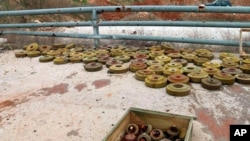Long after the fighting is done and warring parties have laid down their weapons, landmines, unexploded ordnance, improvised explosive devices, and other explosive remnants of war pose a deadly hazard to humans and livestock, render thousands of hectares of land unusable, and destabilize communities.
Compounding this, terrorists, drug traffickers, and criminal gangs exploit poorly-secured munitions stockpiles to obtain the weapons and ammunition they need to continue terrorizing communities, undermine the rule of law, and sow instability.
That is why the United States has invested more than $4 billion in 100 countries since 1993 to remove landmines and unexploded ordnance in post-conflict countries. In 2020, despite unique challenges presented by the COVID-19 pandemic, the United States funded conventional weapons destruction efforts in 49 countries with more than $259 million.
To highlight some of the accomplishments of the U.S. Conventional Weapons Destruction program, every year since 2001, the Office of Weapons Removal and Abatement in the U.S. Department of State’s Bureau of Political-Military Affairs releases an annual To Walk the Earth in Safety report. In early April, it Released its 20th edition.
Some of the highlights include the United States’ work in Yemen, where the United States works closely with a wide range of Yemeni stakeholders, international organizations, and non-governmental organizations to clear landmines and other explosives.
In Iraq, the United States contributed $37.5 million last year toward clearing explosive hazards, and promoted continued mine risk education throughout the country. These efforts are helping the safe return of displaced persons, including communities that were persecuted by ISIS.
In Afghanistan, the United States provides conventional weapons destruction funding and support to help clear landmine and unexploded ordnance contamination left by both the 1979 Soviet invasion and the current conflict.
MANPADS, or Man-Portable Air Defense Systems Recognition Training seminars provided by the Interagency Man-Portable Air Defense Systems Task Force assisted foreign security and customs officials, and national police, in their advanced weapons systems counterproliferation efforts. Virtual training provided officials from the Middle East and North Africa with the skills needed to reduce the threat to civil aviation from MANPADS.
“Despite the pandemic, the United States was able to provide significant cooperation on a range of programs around the world,” said Acting Assistant Secretary of State for Political-Military Affairs Timothy Alan Betts. “We remain committed to Conventional Weapons Destruction and look forward to reinvigorating our efforts in 2021 so that all may “walk the earth in safety.”














